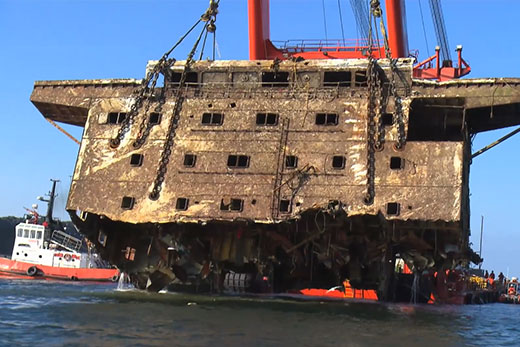Details of the multi-million salvage bill that the Rena has incurred since it hit Astrolabe Reef at 17 knots in October 2011 have been revealed by Swedish Club claims manager John Owen.
The single largest cost was the 180 million US dollars paid to Svitzer & Smit JV/Braemar Howells from October 2011 to April 2012 for oil recovery and the initial salvage phase.
Sawing off, recovering and scrapping the Rena accommodation block cost $US80 million. Photo: File.
Other major lump sums include $US80 million from June 2013 to March 2014 for the accommodation block removal, and $US88 million spent on the major debris field clearance by Resolve Salvage and Fire.
Reducing the bow section over the course of 12 months from July 2012 also cost $US 30 million, says John.
The costs were outlined in his submission to the owners and insurers resource consent application, currently being heard at the ASB Arena in Mount Maunganui.
The hearing is set down for three weeks, with the applicant's case expected to be wrapped today. Next up is the Bay of Plenty Regional Council, which supports the application, followed by the Crown and Maori trusts.
John is normally based at the Piraeus branch of The Swedish Club, but has visited New Zealand at least ten times over the last four years accompanying owner Konstantinos Zacharatos during the community engagement process.
The Swedish Club is a protection and indemnity insurance club – a mutual insurance association that provides risk pooling, information and representation for its members.
'The process of determining outcomes for the Rena has not always been a two-way street,” says John.
'For example, the owner and the club were not invited by government agencies to get involved in setting targets for the Rena Long Term Recovery Programme.
'This Programme aimed to restore the mauri of the reef to its pre-Rena state. The engagement we have had with Te Arawa representatives has helped us to understand how this Maori concept is able to be recognised in the proposal. '
Other costs are include recovering all accessible containers ($US10.7m), a dive survey of the aft Section ($US5.6m), initial debris field clearance ($US5.4m), recovery of plastic beads ($US19m), remnant oil investigation and recovery ($US5m) and continuing debris field clearance and copper recovery ($US6m).
Approximately US$220 million has been spent since announcing the intention to seek resource consent to abandon the wreck.
He adds the timeframes in which work was planned were not typically achieved throughout this project. The time estimate and the cost has often been out by a factor of two.
This is in part due to conditions on the reef allowing working conditions for roughly half the days, which meant that equipment on expensive daily rates was often underutilised in terms of its capacity.
'In this casualty, the remoteness of many of the available assets and resources, and the logistics of bringing those assets to New Zealand, has meant that it has been an ongoing challenge to marshal and optimise available assets and resources,” adds John.



4 comments
Proper job
Posted on 11-09-2015 14:03 | By DAD
if they had done the job correctly they would have employed a firm that could take it all away immediately, taking the cheaper salvage firm hasnt paid off for them but that is not our fault! If it is so good out there why dont they lift the ban on public going there! The photos and videos being put up could be anywhere!
Cost Irrelevant
Posted on 11-09-2015 17:25 | By Gigilo
Simple science remove your rubbish! No use paying off unmandated groups to remove your responsibilities!Forget the excuses Swedish Club and get on with it. By the way a report on how much of that 220 million was paid to NZ businesses would be enlightening.
Our waters
Posted on 11-09-2015 19:33 | By NZgirl
Your ship now shift it. Your Captain crashed the damn thing on the reef not us.
Hey dad
Posted on 11-09-2015 22:22 | By Bop man
Next time you happen to pass the port check out how big the ships are and one stuck on top a reef with a mighty rock sticking up through the hull isn't going anywhere fast. In saying that how does it cost 5.6million to do a dive survey. A bit of profiteering going on here I think.
Leave a Comment
You must be logged in to make a comment.